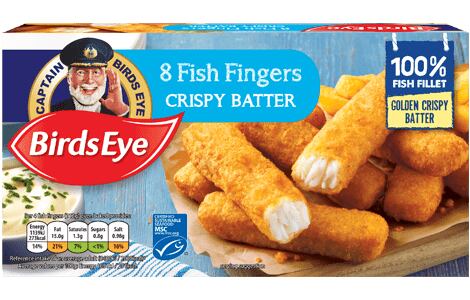The coronavirus pandemic has proven disastrous for many in the food sector. From shuttered foodservice to outbreaks in meatpacking facilities, the industry has been left far from untouched.
However, some segments have experienced unprecedented demand amid lockdowns and imposed social distancing measures. One such sector is frozen food, noted Steve Challouma, General Manager UK, Birds Eye.
Owned by Europe’s largest frozen food company Nomad Foods, Birds Eye sells a range of frozen food products – from fish and seafood to chicken and vegetables – across the UK.
“What we’ve seen in 2020, and carrying on into 2021, is an acceleration of growth in the frozen category, of which fish is a key component,” said Challouma during the Norwegian Seafood Council’s 2021 Norwegian – UK Seafood Summit.
Demand for frozen fish off the hook

In 2020, the total frozen category grew by almost 16% vs a total grocery store growth rate of 8.5%. According to Birds Eye’s Challouma, fish was a ‘key driver’ in that.
It is important to note, however, that frozen food was already in a growth trajectory prior to the COVID-19 outbreak. “If we look back to 2017/18, it was growing 4-5% vs total store [growth of] 1.5-2%,” noted the UK General Manager.
Overall, frozen fish sales grew by approximately 20% - well ahead of total store and total frozen growth. “If we consider that the total growth of frozen food last year was £570m, fish accounted for about a quarter of that, at £144m,” we were told.
Why the sudden rise in frozen fish sales? Challouma puts this notable increase down to a variety of factors. With foodservice closed for much of the year, many more people ate at home in 2020 than had previously. At the same time, home schooling created more opportunities for ‘meal occasions’, from which the frozen fish segment has ‘really benefited’.
Frozen fish offers familiarity, reliability, and is easily stored, he continued. “People have rediscovered the benefits that…frozen fish offers. It’s a real opportunity actually, and there has been a big growth in penetration and a big reappraisal.”
What’s been the biggest catch?
Overall, Birds Eye sees ‘big opportunity’ in frozen fish. This has certainly been buoyed by the recent increase in freezer sales. According to data from Worldpanel Plus, sales of fridge freezers over last summer spiked, indicating a desire for long-lasting foods.
“People have more storage space and [we are observing] a real rekindling of the relationship [with frozen food],” noted the UK General Manager.
So which frozen food products are catching the consumer’s eye?
According to Challouma, the fastest growth product in 2020 was fish fingers, which increased by 23%. A combination of factors influenced this rise in sales, including a greater number of children eating lunch at home.
But children alone were not responsible for the spike, he continued. “Adults at home were having fish finger sandwiches, for example. [They are] trying to make that eating at home experience more interesting and more fun.”
Seafood was another category to experience a surge in demand. From prawns to scampi, seafood grew more than 20% in 2020.

The outright winner in absolute terms, however, was coated fish. The category, which includes cod, haddock and pollock, grew by £50m, said Challouma, who suggested growth was influenced by consumers ‘trying to get their fish and chips at home’.
Consumers reeled in by e-commerce
Another significant change in consumer behaviour, driven by the coronavirus pandemic, is a preference for e-commerce channels in retail.
“It’s been highly disruptive,” noted Challouma, reflecting on the past year, “there has been a surge”.
While frozen food and fish is traditionally over-indexed in e-commerce, Birds Eye observed twice as many sales coming through the e-commerce channel once the pandemic hit. “Pre-pandemic, Birds Eye probably saw about 12% of our sales [coming] through online retailers. Post-pandemic, that has doubled. [These days] probably about a quarter of our sales…are through Tesco.com, Ocado, and the rest of it.”
Further, penetration has increased in all age groups – particularly in older demographics. Challouma believes the pandemic forced retired consumers to test it out. “They’ve tried it and they’ve stuck around and liked it.”
Moving forward into 2021, e-commerce sales haven’t relented. Birds Eye observed some of its highest weeks of sales last month since March 2020. The UK General Manager expects this trend to stay, with more people buying bigger baskets at a greater frequency.





